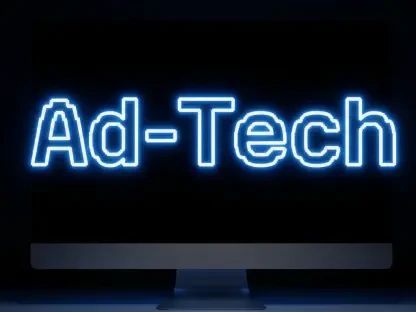Apple’s launch of Vision Pro marks a pivotal shift in mobile technology, introducing the innovative visionOS and bringing spatial computing to consumers. This breakthrough extends beyond mere wearables, prompting a revolution in mobile app marketing. As the device leverages hands, eyes, and voice for interaction, marketing strategies rooted in the touchscreen era face obsolescence. Mobile app marketers must now adapt to an immersive three-dimensional platform, reimagining their approach to app promotion. The change is significant; it beckons a new chapter where old tactics give way to inventive methods attuned to this advanced user interface. As we enter this new phase equipped with the Vision Pro, both the tech landscape and the practices of mobile app marketing are set for a transformative journey, one that will shape the industry’s future for years to come.
The Launch and Immediate Impact of Apple Vision Pro
The launch of Apple Vision Pro on February 2nd, 2024, was a milestone in the technology industry, with the device being earmarked as a paradigm shift in how users interact with digital content. With an international release slated before the influential WWDC in June, the device’s immediate impact was palpable. It brought to the forefront not just a new hardware piece but sparked the ignition of a new ecosystem that will necessitate a rethink of app marketing methodologies.The introduction of over 600 apps specifically designed for the Apple Vision Pro at its launch marked the beginning of this conceptual shift. Within weeks, the app count surged past a thousand. This growth wasn’t just numeric; it was a sign of solidifying support from Apple and a testament to the enthusiasm with which developers embraced the opportunities posed by visionOS. The peripheral compatibility with over 1.5 million iOS apps further accentuates the scope and potential of this new marketplace, signifying a pivotal moment for marketers to step into the future.
App Store Evolution with visionOS
With the emergence of the Apple Vision Pro and its visionOS, marketers face an App Store unlike any before. Rooted in spatial computing, the dedicated platform pivots away from conventional marketplaces with tailored algorithms designed for a three-dimensional experience. This shift demands fresh optimization strategies to ensure visibility and conversion in an ecosystem that redefines user-app interaction.Ensuring backward compatibility, Apple has made it possible for a host of existing iOS apps to find their place within the visionOS ecosystem. This compatibility bridges the gap between established app libraries and the pioneering world of spatial computing, presenting a vast array of opportunities for developers and app marketers. The key lies in navigating these new frontiers with agility and foresight as the marketplace evolves in real-time.
Adjusting ASO Strategies for Spatial Computing
Spatial computing on the Apple Vision Pro has overhauled traditional App Store Optimization (ASO). Where once touch and type dictated interaction, now eyes and voice carve the user journey. This transformation means reconsidering how apps are discovered in a realm where visuals and voice hold unprecedented significance. Marketers accustomed to ASO for two-dimensional interfaces must adapt to this enriched spatial ecosystem.The leap from flat screens to a three-dimensional interface also transforms the search function, a cornerstone for app discovery across iOS and iPadOS platforms. This sea change in fundamental interaction paradigms offers a challenge just as much as it emboldens new vistas for app visibility. Marketers must reinvent their strategies, embedding innovation at the core to harness the full potential offered by Vision Pro’s unique user experience.
Voice Dictation and Its ASO Implications
With the physical keyboard rendered obsolete on Apple Vision Pro, the primary mode of user input has shifted to voice dictation, the look and pinch method, and air typing. This shift demands that ASO strategies are recalibrated towards optimizing for voice search, a more dynamic and context-sensitive medium. It heralds the need to account for the nuances of natural speech, such as different dialects, slang, and acronyms, especially when considering the localization of content.In adapting to this medium, marketers need to invest in understanding the semantic intricacies of how users will phrase queries when speaking, rather than typing. This may mean a more conversational tone in metadata or the anticipation of verbal shortcuts that users might take. With voice dictation becoming increasingly prevalent, optimizing content for the idiosyncrasies of spoken language is not just beneficial but necessary.
Navigating Metadata and Motion Information in the Apple Vision Pro App Store
While retaining many metadata elements from its iOS antecedent, the Apple Vision Pro App Store introduces new considerations in line with the capabilities of visionOS. App names and subtitles are still subject to a 30-character threshold, but the transformative spatial computing interface of the Apple Vision Pro means that descriptions must now reflect its unique features and appeal.One novel element in the Apple Vision Pro App Store is the addition of app motion information. This is a crucial piece of metadata that serves to both inform and protect the user by outlining how an app utilizes the physical space around them. Ensuring accuracy and clarity in app motion descriptions is paramount not only for user safety but also for trust and transparency in this cutting-edge market.
Creative Visual Content in a Spatial Environment
With the immersion of spatial computing brought by the Apple Vision Pro, visual assets for apps must undergo a radical re-envisioning. App icons, now required to be round, lead the charge into a more dynamic and visually captivating interface. When designing screenshots and preview videos, developers must authentically capture the immersive experience innate to the device, offering a genuine taste of the spatial narrative to potential users.These creative efforts are squarely under the microscope of Apple’s rigorous guidelines, which dictate adherence to a set of standards closely tied to the visionOS environment. Any deviation may lead to rejection during the review process, underscoring the importance of precision and accuracy in adhering to Apple’s vision of content that enriches the spatial landscape.
Pricing and Market Adoption Considerations
Positioned at a premium price point of $3499, the Apple Vision Pro represents a significant investment for consumers. This pricing strategy raises essential questions about the device’s immediate widespread adoption, which could, in turn, influence the pace at which app marketers commit resources to this new platform. Nevertheless, the allure of early adoption and the ambition to lead in innovation may prove irresistible for both users and developers alike.As the Apple Vision Pro carves out its market niche, marketers must weigh the implications of this pricing structure in their strategic planning. This assessment must not only factor in the current standing but also forecast the potential shifts in adoption that could arise as the technology permeates mainstream awareness and becomes more accessible.
Staying Ahead in an Evolving Digital Ecosystem
In an ever-evolving digital landscape ushered in by Apple Vision Pro, staying updated with technological advancements and market trends is paramount for app marketers looking to maintain a competitive edge. The ripple effect that this new device and visionOS will have on the app market is ongoing, requiring marketers to remain agile and responsive to the shifts in user behavior and preferences it engenders.Devising and adapting strategies will be crucial for developers aiming to stay relevant and successful in this new ecosystem. It will necessitate a commitment to ongoing learning, experimentation, and a willingness to pivot as new insights into app marketing on the Apple Vision Pro come to light. By embracing the opportunities offered by visionOS and preparing for the transformations ahead, developers can ensure their apps not only survive but thrive in the new era of spatial computing.









